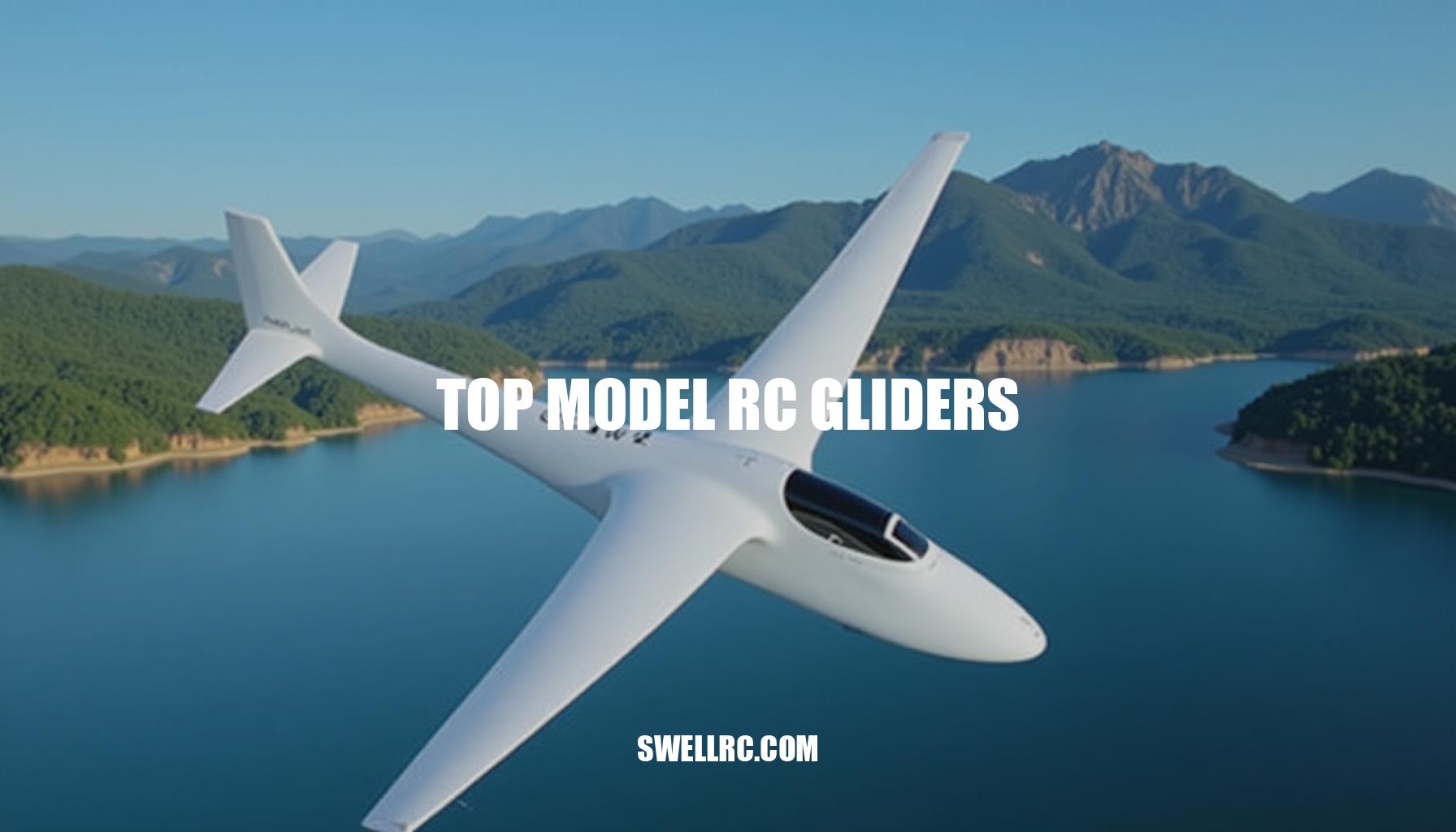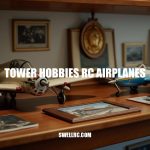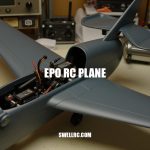Top Model RC Gliders: Expert Guide to Aerodynamic Excellence
The first time I watched a sleek white sailplane hook a thermal and spiral skyward with no motor noise at all, I realized I wasn’t just looking at a toy—I was watching a masterclass in aerodynamics made small. That single climb sparked a deep curiosity about what separates an ordinary glider from a top performance RC glider: the right airfoil and wing loading, the stiffness of a carbon-reinforced spar, the precision of tiny control inputs that translate into effortless altitude. If you’re here, chances are you want the same thing I do—precision control, endurance, aerodynamic efficiency, and materials that convert every puff of lift into unshakeable stability and range.
In this guide, we’ll break down the essentials of aerodynamics in RC planes, compare leading RC sailplanes, and share practical tuning tips to enhance your remote control flying experience. We’ll also point you to curated categories like RC gliders and sailplanes you can explore when you’re ready to shop. Whether you’re into slope soaring gliders, thermal hunting, or just craving Zen-like, motorless RC planes, the path to a top-tier radio-controlled aircraft experience starts with understanding what truly matters in the air—including optimizing glide ratio and maximizing endurance for longer, more rewarding flights.
What defines a top model RC glider?
The best RC gliders don’t just float effortlessly; they transform air into performance advantages through smart design and build choices. Core to this is aerodynamic efficiency, achieved by selecting the right wing shape and high lift wings that optimize glide ratio and minimize sink rate. For instance, slim, high-aspect ratio wings typically offer superior glide and lower sink rates, enhancing thermal cruising abilities.
Material composition plays a pivotal role as well.
Choices like balsa vs composite vs foam impact not only weight but also stiffness and durability. Foam provides a forgiving structure ideal for beginners, balsa offers lightness and lively responsiveness, and composites deliver unmatched stiffness, critical for maintaining aerodynamic profiles under load.
Maintaining structural stiffness with carbon spars and composite skins preserves the intended airfoil shape and supports control system precision. Clear, slop-free linkages along with accurate servos and fine-tuned radio settings allow pilots to reliably translate inputs into smooth, repeatable maneuvers.
Effective energy management also counts: features like sealed hinge lines and a tight canopy fit reduce parasitic drag, boosting overall aerodynamic efficiency for longer flight durations.
Proper attention to the center of gravity and ballast is essential—adjustable CG and added ballast enable optimal performance under varying conditions, such as adding weight and moving CG forward for windier days or going lighter with a slightly aft CG for weak lift.
Launch and landing manners round out the essentials, with predictable hand launches and crisp discus-launch techniques (especially for DLGs) and stable low-speed handling during approaches.
To illustrate the importance of wing geometry in behaviors and trade-offs, consider the following comparison table:
| Planform | Strengths | Trade-offs |
|---|---|---|
| High-aspect straight wing | Best L/D, low sink, excellent thermal cruise | More sensitive to turbulence, higher tip-stall risk if mishandled |
| Moderate taper with dihedral | Stable, forgiving, easy roll-yaw coupling for beginners | Slightly lower max L/D vs. high-aspect race designs |
| Elliptical/optimized composite wing | Superb efficiency, smooth stall, great handling | Higher cost and complexity |
If you’re exploring all build paths—from foam ARFs to premium kits—this buyer’s guide to RC glider kits is an excellent place to start.
The best top model RC gliders in 2024 – tested and rated
For RC enthusiasts exploring the world of soaring, the top model RC gliders of 2024 offer a diverse range catering to different skill levels and preferences—from the precision-engineered composites to value-packed foamies and classic balsa kits. Among composite RC gliders, the Vladimir Models Explorer 3 (F5J) stands out as a benchmark with outstanding float and exceptional distance capabilities in light air. Featuring a wingspan of 3.8–4.0 m and a glide ratio exceeding 30:1, its carbon composite wing and carbon/Kevlar fuselage deliver surgical energy management, making it ideal for F5J competitors chasing top performance.
Similarly, the Pike Prestige 2PK (F5J) excels in weak thermals, boasting crisp handling and efficient camber presets, offering a wingspan near 3.9 m and comparable glide ratios within the premium price segment.
For those new to soaring or seeking budget-friendly options, foamies like the E-flite Radian 2.0 m (PNP/RTF) offer forgiving stalls and easy launches with a glide ratio ranging from 18–22:1, while the Multiplex Heron 2.4 m provides step-up performance with its Elapor foam and carbon reinforcements. The Heron’s full-span control and wind penetration appeal to intermediate pilots mixing thermal and slope soaring techniques.
Meanwhile, discus-launch glider enthusiasts can appreciate the NAN Models Snipe 2 (DLG), a lightweight marvel (~220–260 g) offering exceptional low-sink rates and superb launch height, perfectly suited for precision thermal work and travel-friendly soaring. Those drawn to timeless charm will find the Minimoa scale classic an attractive choice with its vintage gull-wing design, stable handling, and mid-20s glide ratio, ideal for relaxed slope or thermal soaring and scale aficionados.
Builders and educators have the rewarding option of classic balsa kits such as the Sig Riser 100, promoting hands-on aerodynamics education. With wingspans around 2.5–2.6 m and glide ratios up to 24:1, these kits offer light-lift friendliness and gentle stalls, perfect for trimming and camber experiments. Overall, specifications such as wingspan, flying weight, glide ratio, and materials demonstrate the careful balance between electric vs non-electric RC gliders in this comprehensive lineup.
For a detailed view, consider the following summary table highlighting key specifications:
- Vladimir Models Explorer 3 (F5J): Wingspan 3.8–4.0 m, Carbon composite, Glide ratio 30+:1, Premium price
- Pike Prestige 2PK (F5J): Wingspan ~3.9 m, Spread-tow carbon, Glide ratio 30+:1, Premium
- E-flite Radian 2.0 m: Wingspan 2.0 m, EPO foam, Glide ratio ~18–22:1, Budget-friendly
- Multiplex Heron 2.4 m: Wingspan 2.4 m, Elapor foam + carbon, Glide ratio low- to mid-20s:1, Mid-range
- NAN Models Snipe 2 (DLG): Wingspan ~1.5 m, Carbon DLG layups, High glide ratio for size, Upper mid-to-premium
- Minimoa: Wingspan 2.6–3.0 m, Wood/composite, Glide ratio mid-20s:1, Mid-to-premium
- Classic balsa kit (Sig Riser 100): Wingspan ~2.5–2.6 m, Balsa/ply, Glide ratio ~18–24:1, Budget-to-mid
For those who appreciate elite craftsmanship, browsing CARF’s composite lineup can provide inspiration with high-end electric and non-electric RC gliders that excel in finish and structural standards. These options ensure enthusiasts have access to the best RC glider 2024 models suited not only for competition but also for recreational and educational soaring pursuits.
Comparing design philosophies and build materials
When selecting materials and design features for your RC glider, understanding the differences between balsa vs foam vs composite is crucial as they significantly impact the flight feel, durability, and overall performance. Balsa is an ultra-light material offering a lively, floaty flight experience and excellent responsiveness, particularly favored for its low-speed maneuverability and thermal sniffing. However, its moderate durability demands careful hangar care to prevent damage like hangar rash.
In contrast, foam types such as EPO and EPP are highly forgiving and crash-resistant, making them ideal for beginners and casual soaring. They provide a stable and forgiving flight feel, though at the expense of slightly more drag. For premium performance, composite RC gliders constructed from materials like fiberglass fuselage and carbon fiber spars deliver the highest stiffness-to-weight ratio, smooth skins, and minimal drag, resulting in precise, efficient, and fast flights.
While composites come at a higher cost, the benefits in performance and durability are significant.
Understanding key design elements enhances your glider’s capabilities. Airfoil profiles—ranging from thinner, camber-changing foils optimized for low Reynolds number performance in F5J and DLG competitions to thicker sections offering increased forgiveness—greatly affect lift and handling. The dihedral angles, such as dihedral and polyhedral configurations, influence roll stability and hands-off tracking; more dihedral increases stability and is excellent for beginners and thermal gliders.
Lastly, proper CG balancing is vital: a nose-heavy setup promotes straight tracking but increases sink rate, while an aft CG can improve efficiency at the cost of pitch sensitivity, so adjustments should be made cautiously in small increments.
Below is a comparison table outlining the critical characteristics of these materials to help guide your choice:
| Material | Weight | Durability | Flight feel | Cost |
|---|---|---|---|---|
| Balsa/wood | Very light | Moderate (hangar rash) | Lively, floaty | $ |
| Foam (EPO/EPP) | Light | High (great for learning) | Forgiving, stable | $–$$ |
| Composite (glass/carbon) | Lightest for stiffness | High (structural) | Precise, efficient, fast | $$–$$$$ |
For those interested in durability and high craftsmanship, consider exploring premium builders and curated selections such as Esprit’s premium offerings and Skywing’s high-quality airframes. These manufacturers excel in integrating advanced materials and refined design elements—like optimized airfoil profiles, tailored dihedral angles, and precise CG balancing—to deliver superior performance and longevity in your RC glider experience.
Performance tuning and flying techniques
Turning good airframes into great flyers requires smart setup and strategy, focusing heavily on precise flight trimming to optimize performance. The essential tuning checklist starts with radio setup: remove linkage slop, set neutral sub-trims, confirm symmetrical throws, and add 20–40% expo on elevator and aileron controls to ensure smooth handling. Next, carefully select camber presets tailored to flight conditions—launch with 0 to slight reflex, cruise flat to -0.5°, thermal settings at +1–2°, and speed camber between -1 to -2°—validating these through test glides enhances glide path control.
Maintaining optimal center of gravity is crucial; begin at the manufacturer’s CG recommendation and perform subtle CG adjustment aft in 1–2 mm increments to improve float characteristics. Ballast placement plays a pivotal role for maintaining penetration during windy conditions by adding weight strategically. Implementing control mixes such as aileron-to-rudder for coordinated turns, elevator compensation on flap/crow, and advanced snap-flap functions maximizes control precision.
- Sealing hinge gaps and smoothing covering seams improve surface quality, reducing parasitic drag significantly.
- Keeping wings clean further reduces resistance and enhances overall performance.
Reading the air effectively in varied wind conditions is as important as setup. Spotting thermals by observing bird circling, drifting leaves, or wind shifts allows pilots to exploit thermal lift; starting with wide circles and tightening as the thermal core sharpens optimizes climb efficiency. Slope lift techniques involve figure-eights along the slope face, employing ballast to preserve energy in gusty air.
Mastering energy management through minimal control deflection, utilizing the lightest effective camber, and maintaining efficient bank angles ensures sustained performance.
A mini case study exemplifies these principles: during a light 5–8 kt breeze over sun-warmed ground, pilots enhance gains by shifting CG approximately 1–2 mm aft from safe baselines, applying a thermal camber setting around +1.5°, and initiating tighter turns only after receiving confirmation from telemetry vario beeps indicating lift. Employing crow braking with elevator compensation aids in executing reliable spot landings.
For enthusiasts captivated by ultra-light structure optimization, an insightful guide on weight shaving for indoor models provides a valuable perspective that cross-pollinates well with glider efficiency techniques. Explore this detailed resource here: Weight Shaving for Indoor Designs.
The art and future of RC glider engineering
We are truly entering a golden era in innovation in RC gliders, where advancements in composite technology seamlessly integrate with cutting-edge telemetry systems and AI to redefine flight performance. Smarter composites, such as spread-tow carbon and optimized layups, combined with molded accuracy, deliver stiffer wings at drastically reduced weights, enhancing aerodynamic efficiency.
- Smarter composites: Spread-tow carbon fibers and precise layup optimization yield lightweight, stiff wings that improve glide ratios.
- Telemetry everywhere: Devices like altimeters, variometers, GPS tracking, and ESC telemetry provide live sink and variometer data, enabling real-time refinement of camber and speed for peak performance.
- AI-assisted flight: Emerging autopilot aids harness this rich telemetry to detect lift patterns, recommending optimal speed-to-fly targets while keeping pilots actively involved in decision-making.
- Hybrid power: Ultra-light electric sustainers extend flight range without sacrificing glide quality, especially effective in F5J-style climb-and-cut profiles, representing a leap in hybrid power systems.
- CAD/CAM and rapid prototyping: Innovations such as CNC molds and 3D-printed tooling accelerate iterations, bringing advanced airfoil optimization directly into the hands of hobbyists.
This aerodynamic evolution is complemented by a cross-disciplinary approach to design; classic pattern airframes remind us of the importance of clean lines and low drag. After years of collaborative testing and detailed community data analysis, the key takeaway is clear: stiffness, superior surface quality, and precise control mapping are fundamental to success.
Integrating modern telemetry systems with these high-performance airframes multiplies their capabilities, pushing the limits of what modern RC gliders can achieve. For those interested in a practical example of these innovations, the Great Planes Ultra Sport stands out as a benchmark in design excellence.
Conclusion: The soaring takeaway
Top model RC gliders blend efficient aerodynamics, precise controls, and smart materials to turn invisible lift into altitude on demand. Whether you gravitate to featherweight balsa classics, forgiving foamies, or razor-sharp composite RC sailplanes, the best RC gliders are those that align perfectly with your air conditions, your flying field, and your learning curve. Embracing techniques like slope soaring and thermal soaring allows pilots to maximize flight duration and experience the thrill of extended glides.
Key features to look for include high lift wings, which enhance lift-to-drag ratios and improve climb efficiency in thermals, delivering excellent value for money whether you’re a beginner or an advanced flyer. Keep trimming, keep listening to the air, and keep refining—mastery comes one thermal at a time.
When you’re ready to explore a broad, well-curated selection of RC plane collections, few destinations make it easier than SwellRC’s offerings. Explore a diverse range designed to suit every skill level and soaring style at SwellRC Collections. See you on the next climb!
Frequently Asked Questions
- What makes a good RC glider?
Efficient aerodynamics (appropriate airfoil and aspect ratio), a stiff yet light structure, precise and slop-free controls, a CG that supports both stability and efficiency, and surfaces kept smooth and gap-sealed. Add adjustable camber and ballast so the same airframe can adapt to different air masses. - What are the best RC glider brands in 2024?
Widely respected names include Vladimir Models, Baudis, NAN Models, Aer-O-Tec, Mibo, X-Models, Dream-Flight (for foam slope/thermal), Multiplex, and E-flite. Availability varies by region; check local distributors and community feedback. - Are RC gliders suitable for beginners?
Yes. Foam gliders with dihedral and gentle airfoils (e.g., 2 m EPO designs with simple controls) are ideal. They tolerate rough landings, fly slowly, and make trimming and thermal reading approachable. - How long can RC gliders stay airborne?
It depends on lift and setup. In strong slope lift, flights can be effectively unlimited. In thermals, durations of 20–60 minutes are common; with efficient airframes and good lift, far longer is possible. Electric gliders use brief motor climbs, then soar—battery life mainly limits climb attempts, not glide time. - What’s the difference between RC gliders and sailplanes?
In practice, the terms overlap. “Sailplane” often implies a higher-performance thermal or cross-country glider with sophisticated airfoils and flaps, while “glider” can refer to anything from simple chuck gliders to scale and slope ships. Electric-powered versions are typically called electric sailplanes or e-gliders. - How do materials (balsa, foam, composite) affect flight performance?
Balsa is ultra-light and lively but less ding-resistant. Foam (EPO/EPP) is forgiving and easy to repair, great for learning, but slightly draggier. Composites (glass/carbon/kevlar) offer the best stiffness-to-weight and surface finish, yielding higher efficiency and wind penetration at higher cost. - Which RC glider offers the best value for money?
For beginners, a 2 m foam thermal glider with simple radio setup offers unbeatable value. For intermediates, feature-rich foam/composite hybrids with flaps (e.g., 2.4 m class) are compelling. For experts, used high-end composites often deliver top performance per dollar if in good condition. - Can RC gliders be upgraded with motors or telemetry systems?
Yes. Many gliders accept nose-mounted outrunners or removable power pods; ensure CG remains correct. Telemetry upgrades—altimeter/vario, GPS, and ESC data—are straightforward with modern radios, providing real-time feedback for camber, speed, and climb decisions.



